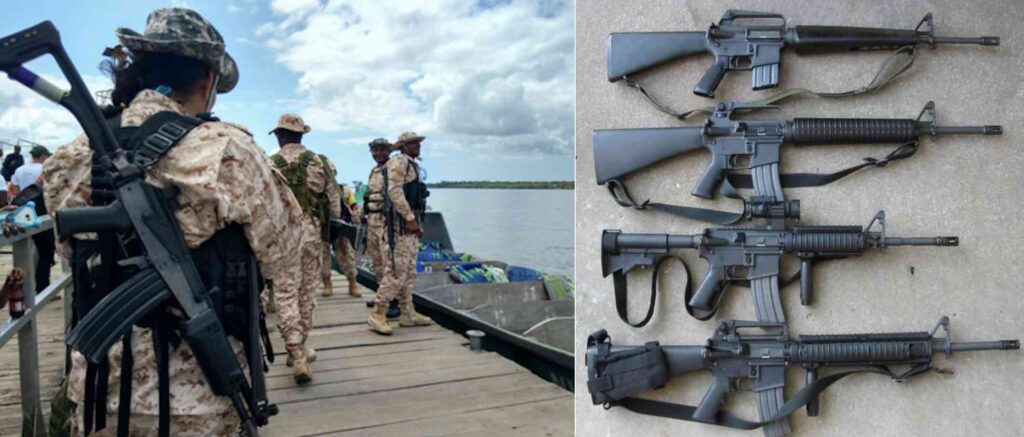Colombia is one of the most dangerous countries in the world due to the massive circulation of fire weapons between various armed groups. All of these weapons have an origin, but the traces of the transactions are rare.

Every year, a massive number of people dies due to guns in Colombia. The first week of 2022 vice-minister of Defence Jairo Garcia announced at least 23 gun related fatalities. Colombia has one of the highest murder rate by fire weapons in Latin America, with 18 deaths for 100,000 inhabitants in 2019. This violence is not only caused by drug cartels – who have a serious influence in the world’s first producer of cocaine – but also by an extremely difficult political context.
Three categories of guerrilleros operate in Colombia. According to the 6th report of the Institute of Studies for Development and Peace (Indepaz) published in octobre 2021, they represents around 10,000 people in the country.
5200 fighters are dissidents from the FARC (Revolutionary Armed Forces of Colombia), the old marxist guerilla. They reject the 2016 peace agreement with the government – which theoretically ended a war that started in the Sixties – and keep fighting with a new generation of rebels that is growing steadily. They are located in 123 colombian municipalities.
The ELN (Ejército de Liberación Nacional) is the only “official” guerilla in Colombia nowadays, inspired by Che Guevara. It has 2450 fighters, active in 136 municipalities. Most leaders are not in Colombia and manage the ELN 8 fronts from abroad. Recently, they were less active against the national forces and more active against the other factions.
In Colombia, “paramilitary groups” are extreme-right factions who face different marxist guerillas. In the 291 municipalities where paramilitaries are active, the most powerful group is the “Clan del Golfo” with 1700 members in 80% of these territories. Their rise is impressive: in 2019, they were present in 30 municipalities only.
Five million guns in Colombia
These three groups own an impressive quantity of weapons. The foundation “Ideas Para La Paz” counts 706,210 legal and 4,267,790 illegal weapons in circulation across the country. Alongside the Galil – the national weapon crafted in the Indumil in Bogota and often stolen or illegally bought by the guerrilleros to official soldiers – other firearms have maltiple origins.
In this photo retrieved from a 5-minute video published in march 26th 2020, Ivan Marquez, the leader of the FARC group “Bloc Segunda Marquetalia” appeared with men, women and children, all armed with rifles. His slogan remains the same: “power taken by the people, for the people”. In this video, we can see a whole arsenal of war weapons including Kalashnikov, Tavor X95, Tavor SAR, P90. And in the foreground: an assault rifle AK-103.
Modern version of the famous AK-47, 100,000 AK-103 were sold by Russia to Venezuela in 2005 and 2006 for 54 million dollars, to renew the old equipment of Chavez’s soldiers. For Colombian authorities this is yet another evidence that members of the “Segunda Marquetalia” are hiding in Venezuelan territory.
Regarding the ELN, the Colombian army announced in June 2020 that it has dismantled a logistical center for its fighters in Cucurrupi where they found a equipment like ammunition for AK-47, Galil and M-16.
Europe, the surprising provider
In the article “la ruta de las balas” published by the website Pacifista on the 24th of december 2017, the Active Reserve Colonel John Marulanda declared that a large amount of weapons entering Colombia come from Ecuador, Venezuela and Brazil. Only 15% of illegal weapons come from the USA. But according to him most of “the arsenal that enters Colombia by Uraba, Darien and the Pacific Ocean is from the old conflicts of the Balkans, and the ex-USSR countries.”
The colonel recalls that the third brigade of the Colombian national army seized 607 assault rifles AKM, a replica of the Russian AK-47, and a lot of QC Norico, a Chinese weapon similar to the American M-16. His analysis is supported by a report from November 2009 entitled “perspectivas sobre control, trafico y uso de armas ilegales en Colombia”, and published by Ideas Para la Paz. It traces the history of arms delivery from the nineties. In July 1999, a boat from Varna (Bulgaria) unloads in Buenaventura (on the Pacific coast of Colombia) 7640 AK-47 M1A1 rifles crafted in the Bulgara Arsenal Kazanlak. On the other side, the Autodefensas Unidas de Colombia (AUC, dissolved in 2006) bought 30,000 AK-47 to the Nicaraguayan police.
According to the report, the AUC held rifles, guns and carabines like Colt Match Target, M-16, AR-15 and Winchester M-14 from the USA, AK-47 from Russia and Bulgaria, M1A1 from Bulgaria, AMD-65 from Hungary and machine guns PKM from Russia.
During the 21st century, the FARC managed to strengthen its arsenal in order to fight the State. They invested in sniper rifles, and bought heavier weapons like anti tank rockets AT-4, originally sold by Sweden to Venezuela.
Across the board, Colombias remains massively armed despite the fall of the USSR : the amount of arms was 9,497 per 100,000 inhabitants in 1994, now it is 10,091.
Anthony Derestiat, Floriane Padoan and Florian Mestres
BLACK BOX
For this investigation, we looked for pictures of members of the main guerilla groups in Colombia, namely : the dissidents of FARCS, those of the ELN and those of the Clan del Golfo (main paramilitary organization). We focused on several social networks (Facebook, Twitter, Gettr) but also used photos illustrating journalistic articles found with Google. In total, we reviewed over a hundred photos.
Next, we analyzed the weapons in question with Google Lens and the reverse search on Google Images. The purpose was to get an idea of the model of the weapon and, doing so, retrace their origin. The results were not very conclusive: a single image of a weapon gave an erroneous result that seemed credible, Google Lens having mistaken the kalashnikov model.

We then moved to the naked eye analysis by comparing the photos to the weapon models we could find, especially on Wikipedia. Here we managed to recognize some weapons. However, some details not visible in the photos could distort the result regarding the model of the weapon, but not its brand.
Finally, we used press articles, videos, NGO reports and Foundation investigations, and also information given directly by the army. We were able to collect some very interesting data. In particular, statistics on the number of homicides in the region, the history of firearms in Colombia and the ideological and political connections between the Colombian armed mobilities and certain neighbouring countries (Venezuela) or with a certain international weight (Russia).

